-
Countries
-
Data and Analysis
-
Special Focus
-
Crisis Responses

Contact
DTM Chad, dtmtchad@iom.int
Language
English
Location
Chad
Snapshot Date
Jun 03 2024
Activity
- Mobility Tracking
- Event Tracking
• Nearly 750,000 people have crossed into Chad since the onset of the crisis in Sudan. IOM estimates that more than 173 124 mong them are Chadian returnees and expects this number to rise to240 000 by the end of April 2024, due to ongoing conflict in Darfur and the current suspension of the humanitarian corridor between Adré and Darfur.
• IOM, as the lead agency for the returnee response, collaborates with a range of operational partners including the Government of Chad, UNHCR, OCHA, LWF, PUI, UNICEF, MSF, UNFPA, LMI, ICRC, IRC, ACTED, the Chadian Red Cross, HELP-Tchad, ATURAD, Concern Worldwide, COOPI, INTERSOS, and WFP.
• In coordination with CNARR and humanitarian organizations, IOM has registered 122 191 returnees and identified 365 third-country nationals (from South Sudan, Niger, Ethiopia, the Central African Republic, Burkina Faso, Sierra Leone, Nigeria, and Uganda) 52 localities in three provinces.
• Most of the returnees currently live in spontaneous locations near the border and are in urgent need of food, water, sanitation and hygiene, shelter, household items, health, and protection.
• IOM is developing the returnee communities of Tongori, Ouaddaï province, and Deguessa, Sila province which, with over 13,000 and 25,000 individuals respectively, are the two largest returnee sites in eastern Chad. IOM and partners offer shelter, NFI, WASH, MPCA, and Protection/MHPSS assistance in those two sites.
• IOM coordinates with local authorities and diplomatic representations for the voluntary return to their home countries of third-country nationals (TCNs) from countries including Ethiopia, South Sudan, Nigeria, Niger, and Cameroon previously living in Sudan and displaced to eastern Chad.
• Moreover, IOM is the lead agency in resiliency programming among returnees and host communities. This implies transitioning from temporary shelters to more durable housing solutions, to support livelihoods opportunities and improve access to basic needs and services. Adjunctly to this, IOM also supports the Humanitarian, Development and Peace Nexus which seeks to strengthen relations between the different communities for longstanding peace.
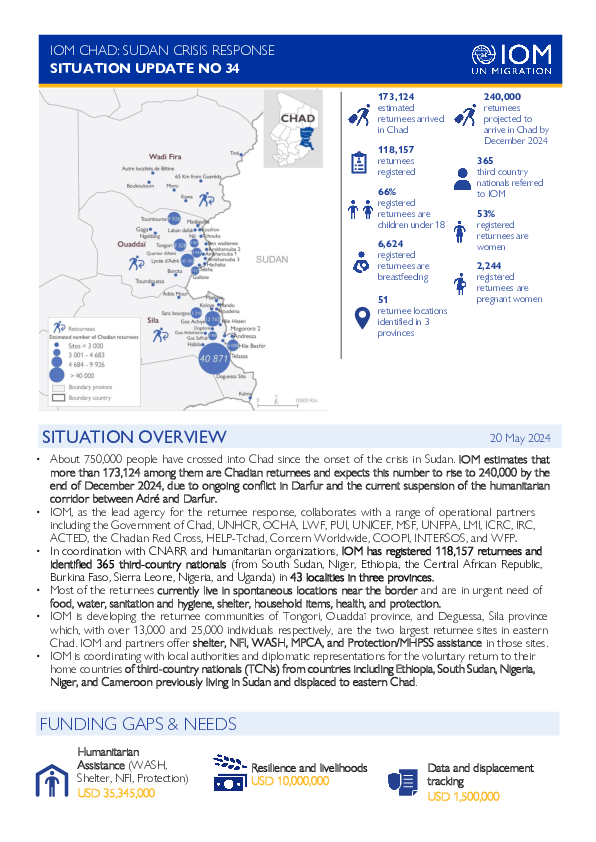
Contact
DTM Chad, dtmtchad@iom.int
Language
English
Location
Chad
Snapshot Date
May 20 2024
Activity
- Mobility Tracking
- Event Tracking
• About 750,000 people have crossed into Chad since the onset of the crisis in Sudan. IOM estimates that more than 173,124 among them are Chadian returnees and expects this number to rise to 240,000 by the end of December 2024, due to ongoing conflict in Darfur and the current suspension of the humanitarian corridor between Adré and Darfur.
• IOM, as the lead agency for the returnee response, collaborates with a range of operational partners including the Government of Chad, UNHCR, OCHA, LWF, PUI, UNICEF, MSF, UNFPA, LMI, ICRC, IRC, ACTED, the Chadian Red Cross, HELP-Tchad, Concern Worldwide, COOPI, INTERSOS, and WFP.
• In coordination with CNARR and humanitarian organizations, IOM has registered 118,157 returnees and identified 365 third-country nationals (from South Sudan, Niger, Ethiopia, the Central African Republic, Burkina Faso, Sierra Leone, Nigeria, and Uganda) in 43 localities in three provinces.
• Most of the returnees currently live in spontaneous locations near the border and are in urgent need of food, water, sanitation and hygiene, shelter, household items, health, and protection.
• IOM is developing the returnee communities of Tongori, Ouaddaï province, and Deguessa, Sila province which, with over 13,000 and 25,000 individuals respectively, are the two largest returnee sites in eastern Chad. IOM and partners offer shelter, NFI, WASH, MPCA, and Protection/MHPSS assistance in those sites.
• IOM is coordinating with local authorities and diplomatic representations for the voluntary return to their home countries of third-country nationals (TCNs) from countries including Ethiopia, South Sudan, Nigeria, Niger, and Cameroon previously living in Sudan and displaced to eastern Chad.

Contact
iomnigeriadtm@iom.int
Language
English
Location
Nigeria
Period Covered
May 27 2024
Jun 02 2024
Activity
- Registration
- Rapid Emergency Registration
Between 27 May and 2 June 2024, a total of 1,259 new arrivals were recorded at locations in Adamawa and Borno states. The new arrivals were recorded at locations in Askira/Uba, Bama, Gwoza, Kaga, Monguno, and Ngala Local Government Areas (LGAs) of the most conflict-affected Borno State and in Fufore, Gombi, Hong, Madagali, Maiha, Michika, Mubi North, Mubi South, Song, Yola North and Yola South LGAs of Adamawa State.
ETT assessments identified the following movement triggers: poor living conditions (396 individuals or 31%), military operation (313 individuals or 25%), seasonal farming (216 individuals or 17%), fear of attack (130 individuals or 10%), family re-unification (99 individuals or 8%), improved security (94 individuals or 7%) and access to humanitarian support (11 individuals or 1%).
Contact
dtmlebanon@iom.int
Location
Lebanon
Activity
- Mobility Tracking
- Baseline Assessment
Period Covered
Oct 10 2023 -May 28 2024
Since October 8 there has been an increase in cross-border incidents between Israel and Lebanon, resulting in the displacement of people both within the South and elsewhere within the country. Since October 10, the Displacement Tracking Matrix (DTM) has been conducting the daily monitoring of population movements. The objective of the exercise is to inform preparedness and response planning.
Population Groups
IDPs
Returnee (Previously Internally Displaced)
Survey Methodology
Unit of Analysis Or Observation
Admin Area 2
Admin Area 3
Household
Individual
Type of Survey or Assessment
Key Informant
Keywords
Geographical Scope Full Coverage
Administrative boundaries with available data
The current dataset covers the following administrative boundaries
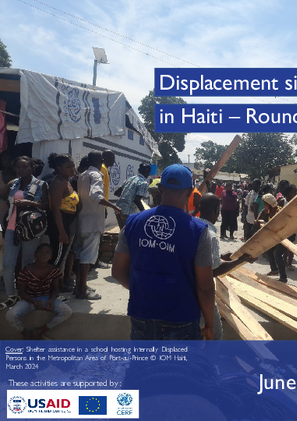
Contact
DTM Haiti, dtmhaiti@iom.int
Language
English
Location
Haiti
Period Covered
Apr 24 2024
May 31 2024
Activity
- Mobility Tracking
- Baseline Assessment
- Site Assessment
- Village Assessment
The Round 6, published in early March 2024, indicated that 362,551 people were
internally displaced in Haiti. This new Round indicates the presence of 578,074 internally displaced people, almost 60%
more than in Round 6. This increase is due to the deterioration of the security situation observed in the MAPAP, Haiti’s
capital, between the end of February and April 2024 in particular. The increase in the number of IDPs was more
identified in provinces where it increased by 95% (compared to 15% in the MAPAP). Indeed, following the increase in
violence in the MAPAP, many people fled the capital to seek refuge in provinces.
The Great South was the region that saw the largest increase in the number of IDPs hosted there (130% more
compared to Round 6). Nearly half (47%) of IDPs in the country are located in the Great South.
The majority of IDPs in the country are hosted in provinces: 68% in provinces vs. 32% in the MAPAP
The IDPs in provinces are mainly people who fled the MAPAP: 78% of IDPs in provinces came from the MAPAP.
Artibonite, where half of the IDPs fled areas located in this department, is an exception. In all other departments of the
country, IDPs mainly came from the MAPAP.
At the national level, the majority of IDPs are hosted by host families: 80% vs 20% in sites. However, in the MAPAP,
the majority of IDPs reside in sites (61% in sites vs 39% in host families), while in provinces the opposite is true (97% in
host families vs 3% in sites). It is crucial to support host communities in provinces, particularly in the Great South, to
enable them to continue hosting IDPs; and it is important to promote social cohesion between these two population
groups. Without the resilience of host communities, the number of sites in provinces is likely to increase as has been the
case in the MAPAP. Indeed, at the beginning of the crisis, the majority of IDPs in the MAPAP were hosted by host
families: only about 2 out of 10 IDPs were in sites in 2022; this figure increased to 6 out of 10 IDPs in 2023. One of the
main reasons for this increase was the lack of resources of host communities to continue hosting IDPs and the
deterioration of social cohesion in this context.
In addition, 50,000 returnees formerly IDPs were identified, particularly in the MAPAP, in Croix-des-Bouquets (21%),
Cité Soleil (14%), Port-au-Prince (12%); in the South in Tiburon (19%); and in the Center in Sauts d’Eau (10%). It should
be noted that for the moment these returns remain very fragile and are not sustainable, particularly in the MAPAP.

Contact
DTM Haiti, dtmhaiti@iom.int
Language
English
Location
Haiti
Period Covered
Feb 24 2024
May 31 2024
Activity
- Mobility Tracking
- Baseline Assessment
- Site Assessment
- Village Assessment
The Round 6, published in early March 2024, indicated that 362,551 people were
internally displaced in Haiti. This new Round indicates the presence of 578,074 internally displaced people, almost 60%
more than in Round 6. This increase is due to the deterioration of the security situation observed in the MAPAP, Haiti’s
capital, between the end of February and April 2024 in particular. The increase in the number of IDPs was more
identified in provinces where it increased by 95% (compared to 15% in the MAPAP). Indeed, following the increase in
violence in the MAPAP, many people fled the capital to seek refuge in provinces.
The Great South was the region that saw the largest increase in the number of IDPs hosted there (130% more
compared to Round 6). Nearly half (47%) of IDPs in the country are located in the Great South.
The majority of IDPs in the country are hosted in provinces: 68% in provinces vs. 32% in the MAPAP
The IDPs in provinces are mainly people who fled the MAPAP: 78% of IDPs in provinces came from the MAPAP.
Artibonite, where half of the IDPs fled areas located in this department, is an exception. In all other departments of the
country, IDPs mainly came from the MAPAP.
At the national level, the majority of IDPs are hosted by host families: 80% vs 20% in sites. However, in the MAPAP,
the majority of IDPs reside in sites (61% in sites vs 39% in host families), while in provinces the opposite is true (97% in
host families vs 3% in sites). It is crucial to support host communities in provinces, particularly in the Great South, to
enable them to continue hosting IDPs; and it is important to promote social cohesion between these two population
groups. Without the resilience of host communities, the number of sites in provinces is likely to increase as has been the
case in the MAPAP. Indeed, at the beginning of the crisis, the majority of IDPs in the MAPAP were hosted by host
families: only about 2 out of 10 IDPs were in sites in 2022; this figure increased to 6 out of 10 IDPs in 2023. One of the
main reasons for this increase was the lack of resources of host communities to continue hosting IDPs and the
deterioration of social cohesion in this context.
In addition, 50,000 returnees formerly IDPs were identified, particularly in the MAPAP, in Croix-des-Bouquets (21%),
Cité Soleil (14%), Port-au-Prince (12%); in the South in Tiburon (19%); and in the Center in Sauts d’Eau (10%). It should
be noted that for the moment these returns remain very fragile and are not sustainable, particularly in the MAPAP.
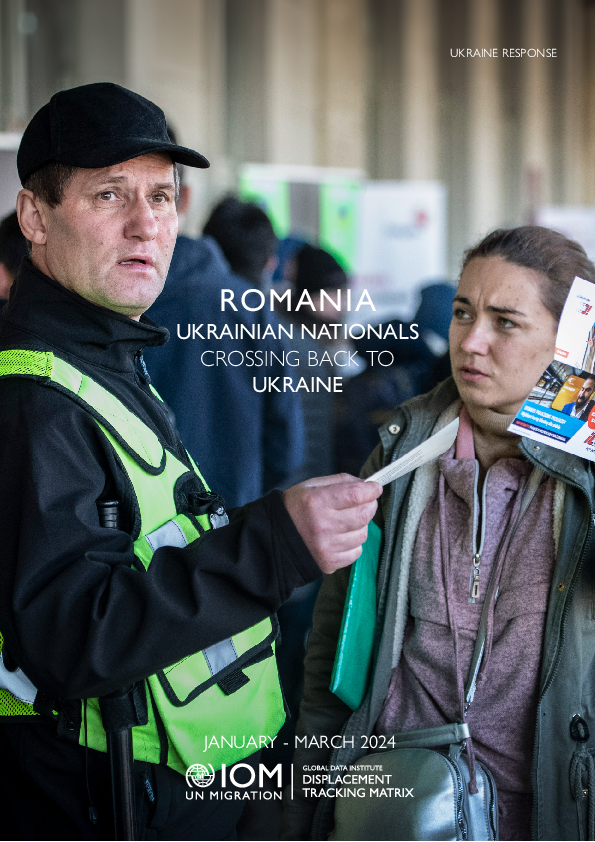
Contact
DTM Europe, DTMMediterranean@iom.int
Language
English
Location
Romania
Period Covered
Jan 01 2024
Mar 31 2024
Activity
- Survey
- Return Intention
- Flow Monitoring
IOM’s Displacement Tracking Matrix (DTM) collected data on Ukrainian nationals and TCNs (resided in Ukraine before 24 February 2022) that were crossing back to Ukraine from or through Romania, either temporarily or permanently. The survey focuses on the return intentions, duration of displacement, destinations, assistance, and experiences of discrimination of respondents. A total of 1,298 surveys were collected between January and March 2024. Among these, less than one per cent (n=11) were completed by TCNs, while the vast majority, comprising over 99 per cent (n=1,287), were completed by Ukrainian nationals. The analysis presented in this report is based on the responses provided by Ukrainian nationals.
Before crossing back into Ukraine, individuals commonly stayed in Romania (57%), other EU countries (36%) or non-EU countries (6%). Aside from Romania, other countries of residence were Bulgaria (18%), Germany (6%), Italy (4%) or Turkey (3%).
The travel intentions of the surveyed Ukrainian nationals show that most respondents (63%) were “short-term visitors”, while 15 per-cent were prospective returnees. Another 22 per cent were not sure regarding their visit period. Also, most UA citizens were travelling back to their oblast of origin (985%), with most respondents originating from Odeska, Chernivetska, City of Kiyv Mykolaivska or Kersonska.
Contact
DTM Yemen, iomyemendtm@iom.int
Location
Yemen
Activity
- Mobility Tracking
- Event Tracking
Period Covered
Jun 02 2024 -Jun 08 2024
From 1 January to 8 June 2024, IOM Yemen DTM tracked 1,530 households (HH) (9,180 Individuals) who experienced displacement at least once.
Between 2 and 8 June 2024, IOM Yemen DTM tracked 38 households (228 individuals) displaced at least once. The majority of people moved into/within the following governorates and districts:
- Ma’rib (22 HHs) – Marib City (13 HHs), Marib (7 HHs), Harib (2 HHs) districts. Most displacements in the governorate originated from Marib and Al Hodeidah.
- Ta’iz (9 HHs) – Mawza (4 HHs), As Silw (4 HHs), Jabal Habashi (1 HHs) districts. Most displacements in the governorate originated from Taiz and Aden.
- Al Hodeidah (7 HHs) – Al Khukhah (6 HHs), Hays (1 HHs) districts. Most displacements in the governorate were internal.
The majority of people moved from the following governorates and districts:
- Al Hodeidah (9 HHs) – Al Marawiah (2 HHs), Bayt Al Faqih (2 HHs), Al Hawak (1 HHs) districts.
- Ta’iz (7 HHs) – Maqbanah (5 HHs), Al Mawasit (2 HHs) districts.
- Marib (4 HHs) – Sirwah (1 HHs), Rahabah (1 HHs), Harib (1 HHs) districts.
Population Groups
IDPs
Returnee (Previously Internally Displaced)
Survey Methodology
Unit of Analysis Or Observation
Admin Area 2
Household
Type of Survey or Assessment
Household
Key Informant
Keywords
Geographical Scope Partial Coverage
Administrative boundaries with available data
The current dataset covers the following administrative boundaries
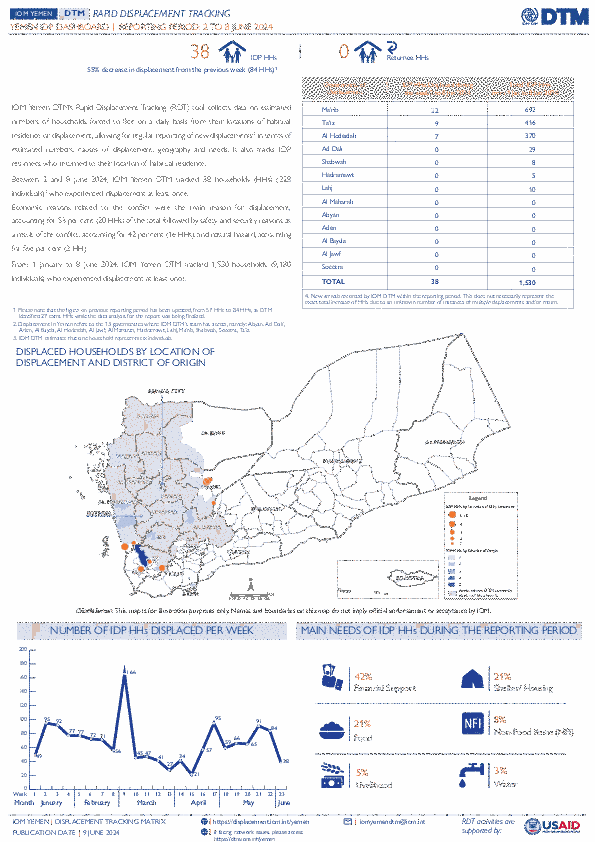
Contact
DTM Yemen, iomyemendtm@iom.int
Language
English
Location
Yemen
Period Covered
Jun 02 2024
Jun 08 2024
Activity
- Mobility Tracking
- Event Tracking
IOM Yemen DTM’s Rapid Displacement Tracking (RDT) tool collects data on estimated numbers of households forced to flee on a daily basis from their locations of origin or displacement, allowing for regular reporting of new displacements in terms of estimated numbers, geography, and needs. It also tracks returnees who returned to their location of origin.
From 1 January to 8 June 2024, IOM Yemen DTM tracked 1,530 households (HH) (9,180 Individuals) who experienced displacement at least once.
Between 2 and 8 June 2024, IOM Yemen DTM tracked 38 households (228 individuals) displaced at least once. The majority of people moved into/within the following governorates and districts:
- Ma’rib (22 HHs) – Marib City (13 HHs), Marib (7 HHs), Harib (2 HHs) districts. Most displacements in the governorate originated from Marib and Al Hodeidah.
- Ta’iz (9 HHs) – Mawza (4 HHs), As Silw (4 HHs), Jabal Habashi (1 HHs) districts. Most displacements in the governorate originated from Taiz and Aden.
- Al Hodeidah (7 HHs) – Al Khukhah (6 HHs), Hays (1 HHs) districts. Most displacements in the governorate were internal.
The majority of people moved from the following governorates and districts:
- Al Hodeidah (9 HHs) – Al Marawiah (2 HHs), Bayt Al Faqih (2 HHs), Al Hawak (1 HHs) districts.
- Ta’iz (7 HHs) – Maqbanah (5 HHs), Al Mawasit (2 HHs) districts.
- Marib (4 HHs) – Sirwah (1 HHs), Rahabah (1 HHs), Harib (1 HHs) districts.
IOM identified 27 additional households displaced in the previous reporting period, which covered 26 May - 01 June 2024, in the governorates of Taiz (12 HHs), Marib (12 HHs), and Al Hodeidah (3 HHs). These figures have been added to the cumulative displacement total recorded since the beginning of the year.
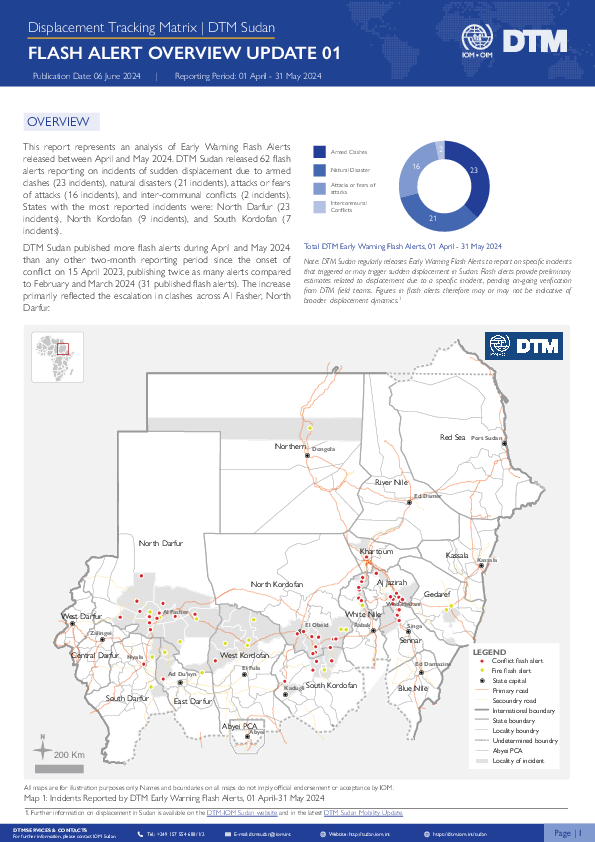
Contact
DTM Sudan; dtmsudan@iom.int
Language
English
Location
Sudan
Period Covered
Apr 01 2024
May 31 2024
Activity
- Mobility Tracking
- Event Tracking
This report represents an overview of DTM Early Warning Flash Alerts published between April and May 2024.
DTM Sudan released 62 flash alerts reporting on incidents of sudden displacement between April and May 2024, including incidents related to armed clashes (23 incidents), natural disasters (21 incidents), attacks or fears of attacks (16 incidents), and inter-communal conflicts (2 incidents). States with the most reported incidents were: North Darfur (23 incidents), North Kordofan (9 incidents), and South Kordofan (7 incidents).
Notably, DTM Sudan published more flash alerts during April and May 2024 than any other two-month reporting period since the onset of conflict on 15 April 2023, publishing twice as many alerts compared to February and March 2024 (31 published flash alerts). The increase primarily reflected the escalation in clashes across Al Fasher, North Darfur.
Note: DTM Sudan regularly releases Early Warning Flash Alerts to report on specific incidents that triggered or may trigger sudden displacement in Sudan. Flash alerts provide preliminary estimates of displacement figures due to a specific incidents. Figures in flash alerts therefore may or may not be indicative of broader displacement dynamics. More comprehensive information about displacement and mobility in Sudan is available in the Sudan Mobility Update. Early Warning Flash Alerts are distributed via the DTM Sudan mailing list.